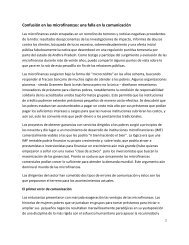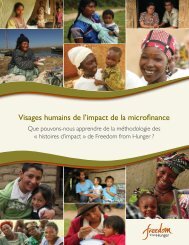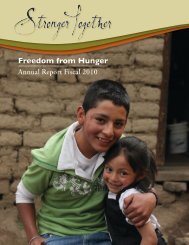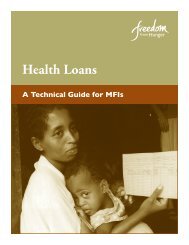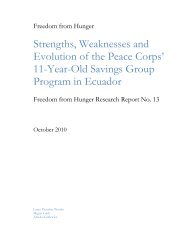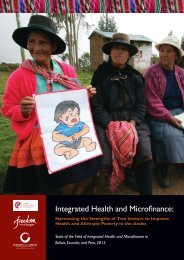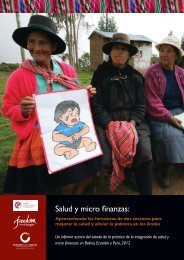history of meals for millions, soy, and freedom from ... - SoyInfo Center
history of meals for millions, soy, and freedom from ... - SoyInfo Center
history of meals for millions, soy, and freedom from ... - SoyInfo Center
Create successful ePaper yourself
Turn your PDF publications into a flip-book with our unique Google optimized e-Paper software.
ecent years, Ceylon has been consuming more than she has<br />
produced, creating a serious negative trade balance.<br />
There<strong>for</strong>e the people <strong>of</strong> Ceylon (Sinhalese) must learn to<br />
make more efficient use <strong>of</strong> her existing food. And they need<br />
more protein in their rice-centered diet.<br />
Dr. Henry Borsook, Pr<strong>of</strong>essor <strong>of</strong> Biochemistry at the<br />
Cali<strong>for</strong>nia Institute <strong>of</strong> Technology <strong>and</strong> Research Director <strong>of</strong><br />
the Meals <strong>for</strong> Millions Foundation <strong>and</strong> original inventor <strong>of</strong><br />
the world famous “3¢ meal–multi-purpose food” points out<br />
that one doesn’t need “to have any animal proteins to be<br />
healthy. The mixture <strong>of</strong> proteins in most vegetables is hardly<br />
ever totally devoid <strong>of</strong> any <strong>of</strong> the indispensable amino acids.<br />
One or two may be low in one food. This relative deficiency<br />
is not the same in all vegetables <strong>and</strong> by mixing two or more<br />
vegetable foods with different relative deficiencies, the<br />
mixture can be nutritionally complete, <strong>and</strong> this is not<br />
difficult to do.” He further points out that “A country’s<br />
nutritional potential should <strong>and</strong> can be measured in terms <strong>of</strong><br />
the essential nutrients in all <strong>for</strong>ms which it grows, whether<br />
they are in foods commonly eaten or not.” (p. 3).<br />
In addition to “the cultivation <strong>of</strong> pulses, attention<br />
should be given to the production <strong>of</strong> leguminous crops<br />
which are rich in vegetable proteins like groundnut <strong>and</strong><br />
<strong>soy</strong>beans. While these crops can be useful in providing<br />
much needed protein, we feel that <strong>soy</strong>bean which through<br />
modern processing methods can be made to yield a<br />
‘complete’ protein that compares favourably with milk or<br />
meat is the crop which should receive the greatest emphasis.<br />
In this connection it may be noted that: ‘Wherever <strong>soy</strong>beans<br />
can be grown–<strong>and</strong> there are few conditions under which<br />
they cannot–they are the cheapest source <strong>of</strong> complete<br />
protein in terms <strong>of</strong> l<strong>and</strong> area required <strong>and</strong> the hours <strong>of</strong><br />
labour employed per pound <strong>of</strong> protein provided.’” (p. 5.<br />
Meals <strong>for</strong> Millions Foundation, International Inter-Affiliate<br />
News, Nov. 1956, p. 8)<br />
“We are glad to make due acknowledgement <strong>of</strong> the<br />
great interest <strong>and</strong> helpfulness the Meals <strong>for</strong> Millions<br />
Foundation is continuing to show, to lead to the day when<br />
Ceylon, like India, will be able to produce her own multipurpose<br />
food <strong>and</strong> help the people to attain a still higher<br />
level <strong>of</strong> health <strong>and</strong> nutrition.<br />
“To re-capitulate, we have attempted in this<br />
memor<strong>and</strong>um, among other things, to show the steps that<br />
may be taken towards raising nutritional levels, bringing<br />
down the cost <strong>of</strong> living, augmenting savings <strong>for</strong> ensuring<br />
better capital investment, emphasising the gravity <strong>of</strong> the<br />
population problem be<strong>for</strong>e the country, the need <strong>for</strong><br />
adapting food production to meet the nutritional st<strong>and</strong>ards<br />
<strong>of</strong> the population on more scientific lines <strong>and</strong>, pointed out<br />
the importance <strong>of</strong> producing low-cost nutritional<br />
supplements <strong>and</strong> infant foods, especially to help the low<br />
income groups.” (p. 14). Address: All Ceylon Buddhist<br />
Congress.<br />
MEALS FOR MILLIONS, SOY, AND FREEDOM FROM HUNGER 74<br />
© Copyright Soyinfo <strong>Center</strong> 2011<br />
178. Pawley, Walter H. 1963. Possibilities <strong>of</strong> increasing<br />
world food production. Rome, Italy: Food <strong>and</strong> Agriculture<br />
Organization <strong>of</strong> the United Nations. ix + 231 p. Illust. (part<br />
color). Map (folded color). 23 cm. Series: Freedom <strong>from</strong><br />
Hunger Campaign, Basic Study No. 10 *<br />
Address: Director.<br />
179. Photograph <strong>of</strong> (left to right) Nelda Clinton, Clif<strong>for</strong>d<br />
Clinton, Fred Patterson, Jean Davis <strong>and</strong> her son, David.<br />
1963.<br />
• Summary: Fred Patterson was Nelda’s father. Jean Clinton<br />
Davis was the daughter <strong>of</strong> Clif<strong>for</strong>d <strong>and</strong> Nelda. Taken in<br />
1963, in Jean’s living room in Los Angeles, after the<br />
untimely death <strong>of</strong> her husb<strong>and</strong>.<br />
This photo <strong>and</strong> date were sent to Soyinfo <strong>Center</strong> by<br />
Donald Clinton, son <strong>of</strong> Clif<strong>for</strong>d Clinton (Jan. 2011).<br />
180. Hall, Elizabeth. 1964. Food <strong>for</strong> the future: Millions <strong>of</strong><br />
tiny microbes, known as yeast cells, filled with vitamins <strong>and</strong><br />
proteins, may relieve the pain <strong>of</strong> children suffering with<br />
kwashiorkor <strong>and</strong> other protein deficiency diseases. Science<br />
News Letter 85(1):10-11. Jan. 4.<br />
• Summary: The cells <strong>of</strong> food yeast, Torulopsis utilis, live<br />
on sugar <strong>and</strong> nitrogen; 1,000 pounds <strong>of</strong> food yeast seed can<br />
produce 7,000 pounds (3½ tons) <strong>of</strong> yeast protein per day.<br />
By contrast, a 1,000-pound steer (a giant “protein factory”)<br />
produces only nine-tenths <strong>of</strong> a pound <strong>of</strong> protein a day. 1,000<br />
pounds <strong>of</strong> <strong>soy</strong>bean seed produce only about 82 pounds <strong>of</strong><br />
protein per day under favorable conditions. Food yeast is an<br />
excellent source <strong>of</strong> B-vitamins, however it should be used<br />
only as a supplement, rather than as the sole source <strong>of</strong><br />
protein in a diet.<br />
Another type <strong>of</strong> yeast (Saccharomyces rouxii), known<br />
as “primary dried yeast,” is the familiar type <strong>of</strong> bread used<br />
to leaven bread <strong>and</strong> ferment wine. A one-celled organism, it<br />
reproduces by budding.<br />
Yeast “concentrates are being used in nutritional<br />
supplements such as Multi-Purpose Food sent overseas by



